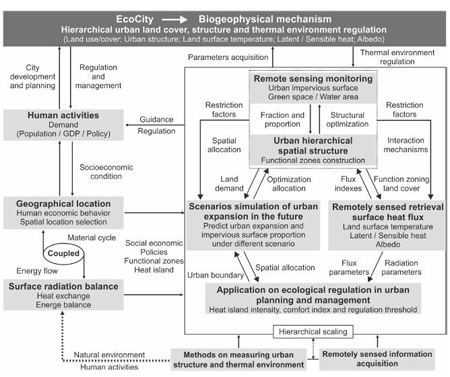Urban land-use/cover changes and their effects on the eco-environment have long been an active research topic in the urbanization fields. Prof. KUANG Wenhui's group at Key Laboratory of Land Surface Pattern and Simulation, Institute of Geographic Sciences and Natural Resources Research (IGSNRR), Chinese Academy of Sciences, developed the EcoCity model for regulating urban land cover structure and thermal environment, and established the eco-regulation thresholds of urban surface thermal environments.
Further studies showed that difference of thermal environments among urban functional areas is closely related to the proportions of the land-cover components. This work was published in Science China Earth Sciences.
Based on multidisciplinary integration of urban geography, urban climatology, and urban ecology, the EcoCity model highly coupled with“spatial location theory” in urban geography, “radiation energy balance” in urban climatology, and the parameterization program for achieving management and application services in urban planning and land-cover components and thermal environment regulation.
The EcoCity model can simulate the future expansion of cities with different scenarios and predict the proportions of urban impervious surface area and greenness and the induced urban heat island effects. The core function of this model is the highly coupling simulation and quantitative inversion results, including the proportion of impervious surface areas in different functional zones, the density of urban heat island, and comfort levels.
The results provide fundamental data sources for regulating the impervious surface ratios in different functional zones and potential urban heat island mitigation in future urban expansion.
Taken Beijing as study area, the researchers found the significantly different surface temperatures in different function zones, especially between urban impervious surface and green space. What’s more, the temperatures in various surface covers were different.
The difference in thermal environments among various urban functional zones is closely related to the composition of major land covers.
The analysis of ecological thresholds of impervious surface and green space within various function zones shows their different roles in thermal regulation effects. The urban-rural frontier and urban interior structure are characterized by high dynamics, structural complexity, and land-cover mosaic, resulting in challenging in obtaining accurate results of urban land cover components.
The EcoCity model and generated high-precision data and map products have been applied in different fields such as the environmental protection, urban planning, and earthquake disaster.
The work was supported by Major Projects of the National Natural Science Foundation of China and General Program of the National Natural Science Foundation of China.
Reference:Kuang W.H. et al. An EcoCity model for regulating urban land cover structure and thermal environment: Taking Beijing as an example. Science China Earth Sciences. 2017,60(6):1098-1109.
 |
|
Figure: Structure of the EcoCity model. (Image by Dr. KUANG Wenhui) |